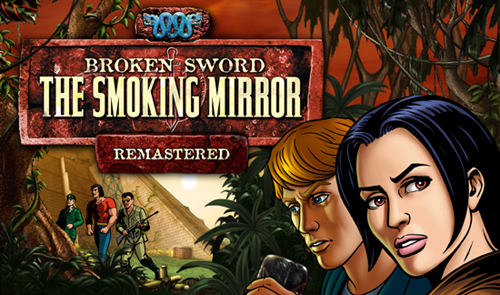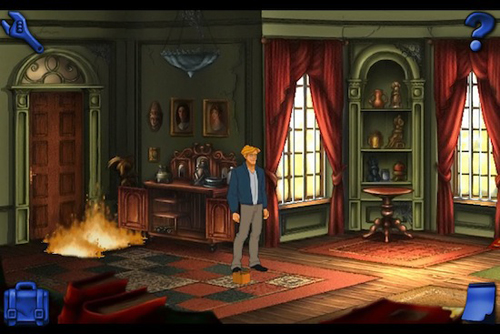《断剑》开发者谈冒险类游戏推iOS版本的意义
最近,冒险类游戏《断剑》又推出了更新版本,除了添加许多新鲜元素,该游戏的续集版本《断剑之烟镜》(Broken Sword: The Smoking Mirror)也已经在上周登陆了iPhone和iPad平台。
据游戏邦了解,Revolution Software工作室的总经理及《断剑》开发者查尔斯·塞西尔(Charles Cecil)在日前的采访中提到了冒险类游戏回归市场的意义,以及苹果平台对开发商的重大作用等话题。下文为访谈内容:
《断剑之烟镜》现在推出了iOS版本(游戏邦注:该版本还将登陆PC、Mac平台),比起上一个版本,新版本中有哪些创新元素最让你们自豪?
这个新版本有许多原版本不具备的强大新功能。
大卫·吉本斯(Dave Gibbons)制作了游戏的漫画效果,我们把它作为游戏中的互动数码图像。它的故事背景也切换到了上一个版本游戏开始前的情形,主要讲述主人公George、Nico如何进入考古学家的住所,他们在那里被袭击、Nico遭绑架的经过。
这个版本的画面和声音效果都大幅度提升了。这款游戏最初是以CD格式发行,所以我们不得不严重压缩游戏内容,然后从单速CD中快速输出内容。现在我们已经重新调整了游戏背景和界面,极大优化了它的声音、音乐等影视效果。
除此之外,我们还添加了一项日志功能,玩家如果中途退出游戏,过后可以通过查看日志了解游戏进程。另外它还增设了一个剧情提示系统。原先我还以为这个系统只会助长玩家的惰性,人人都会对它产生依赖,通过这个捷径找到完成任务的出路,但事实并非如此,这个系统受到了广泛欢迎。
大卫·吉本斯为《断剑》的更新版本制作了漫画效果图,那么在上一版本中他跟你们合作过吗?他对你们来说有何重要意义?
他在许多方面都让我们获益良多。他的漫画非常出色,我甚至可以说我们的游戏得到了世界一流漫画家的支持。
在之前的《Beneath a Steel Sky》,以及我们现在正开发的一款游戏,大卫都跟我在游戏剧情上进行了合作,他负责人物设计以及游戏玩法之外的所有美术视觉元素。大卫不是一个很好的玩家,但他的儿子却成功地担任了这一角色。
在最近几年中,许多曾经风靡一时的传统游戏都纷纷移植到XBLA、iOS等新平台,这种现象已经成为一个趋势。对开发商来说,推出一款游戏的跨平台更新版本是否比单纯的更新版本更重要?
我们更重视开发一款完整的更新版本,而不是直接将游戏快速移植到其他平台。苹果App Store现在已经有30多万款应用,所以那种传统的移植方法是不可行的。我们的上一版本《断剑》已经拥有大量忠实粉丝,如果他们打算购买这个更新版本,也一定会对游戏提出更高的要求,希望获得更多新功能。
不过我们也并非仅仅锁定这些旧玩家,我们也很关注规模更庞大的其他用户,这些用户喜欢人性化的控制系统,我们的剧情提示系统可以让他们的游戏过程更加顺畅。这些用户之前普遍热衷于任天堂DS游戏,但现在也有不少人购买了苹果产品。
《断剑1》刚问世时,玩家对它的评价如何?你们是不是根据这些用户反馈,对《断剑2》进行了调整?
我非常高兴这款游戏获得了粉丝群和新玩家的一致好评,剧情提示系统的功能的确很管用——我们的追踪调查发现用户使用的提示内容、次数差别非常之大。有些人将它视为一款传统的冒险类游戏,因为他们就喜欢挑战。还有些人更看中它的互动剧情,习惯根据提示来执行游戏操作。
我们还发现,如果剧情提示不明确,或者游戏设置的说明不够具体,许多菜鸟级玩家就会卡在某一个环节。所以这一次我们会确保游戏提示覆盖每一个环节的内容,就算我们自己认为提示已经够明确了,也不能在这一点上大意。
请问你认为iPhone、iPad为什么会是冒险类游戏的理想运行平台?
主要有两个原因:首先是产品的创意。这款游戏的界面设计备受称赞,运行效果也很理想,因为这两个平台都有触摸屏设置,这一点是冒险类游戏的理想选择;另外它们的Retina屏幕,也完美呈现了游戏的画面效果,这对2D图像及游戏界面来说非常重要。
如果从商业角度来讲,发行商的主要客户是零售商,他们的目标就是首发当天多卖出几份拷贝版本,以便获得零售市场的支持。但我们的主要客户就是玩家,也希望玩家可以通过我们的服务看到这一点。另外,通过与用户建立直接的联系,我们还能以更优惠的价格让利给用户,通过薄利多销创造更多营收。而且这种途径有助于获得第一手用户反馈资料,让我们的下一款游戏开发少走弯路——大家都知道,手头拮据的融资公司,现在都对开发成本不断攀高的掌机游戏项目特别谨慎。
你们在《断剑》iOS版本的开发过程中可有遇到困难?
基本上很顺利,苹果各方面的服务也很到位。主要挑战就是根据触摸屏功能对游戏进行调整,不过我们之前曾经针对带触摸屏设置的DS平台开发过游戏,所以在这一点上仍然比较占优势。
现在越来越多用户通过手机获取娱乐内容,你认为冒险类游戏应该如何改良,才能适应这些用户在外出过程中的需求?
冒险类游戏是规模更大的休闲游戏用户的理想选择,用户如果对目标隐藏类游戏、以及宝石排列之类的游戏变体感到厌烦了,就可以试试这类游戏。不过我们必须注意的是,过去的冒险类游戏经常有一些解谜元素和挑战,但现在的用户都想快速闯关,不希望时不时就被卡在某一个环节。不过我并不是说用户不喜欢挑战,而是认为如果被卡在难关,他们一般都会想明确知道自己得完成什么任务才能过关。
所以说,那些处心积虑刁难用户,让大家没头没脑地寻找破解答案的游戏不会有太多人捧场了(我还得补充说明一下,我们的游戏可是极力避免这种情况出现)。现在比较受欢迎的是那种任务明确,直接为用户指明方向的游戏。
现在的市场上很流行冒险类游戏,像Telltale和Amanita Design这类开发商现在也正对原来的作品进行改良,并推出了更新版本的《猴岛传奇》(Monkey Island)等游戏,当然《断剑》也属于这一类型,请问你如何看待这种现象?
我们很乐见冒险类游戏的市场需求量上升,要知道这类游戏从1995年就开始没落了,直到最近才刚刚恢复元气。
索尼过去在掌机游戏市场非常成功,最近又频频传出PlayStation的一些新闻,这可以说明他们正极力争取一个新的用户群体,这些用户多为热衷3D游戏的年轻人。在当前形势下,不少发行商、零售商都在扎堆兜售这类3D游戏,但只有具备高水准动画效果的3D游戏才能最终胜出。我们忽视的一块市场就是那些之前喜欢冒险类游戏,但后来又不再玩这类游戏的群体。但现在有了更新型、更休闲的游戏平台,这些玩家又都重新归队了。
我认为冒险类游戏还会持续繁荣发展。虽然大家都喜欢通过互动式媒价了解精彩的故事,但我们一定要清楚,玩家所喜欢的故事讲述方式、游戏任务设置等内容,都已经不同以往了。(本文为游戏邦/gamerboom.com编译,转载请注明来源:游戏邦)
The original Broken Sword has seen no shortage of re-releases in its time.
What’s different about the latest release is not only has the title been completely remastered with fresh additions, but it also arrived on Apple’s mobile platforms at a time when the adventure game genre is experiencing a rise in popularity.
A remastered version of the sequel, Broken Sword: The Smoking Mirror, was released for the iPhone and iPad last week.
We spoke to Charles Cecil, managing director of Revolution Software and creator of Broken Sword, to discover what these remasters mean to him, what makes Apple’s devices perfect for developers and why the return of adventure games is more than a flash in the pan.
Broken Sword: The Smoking Mirror has been re-released on iOS formats (with PC and Mac to follow). What are you most proud of with the latest version that you weren’t able to include in the original?
As with its predecessor, we felt that it was important to include plenty of enhancements and new features over the original.
Dave Gibbons has created new comic artwork, which we offer as an interactive digital comic from within the game. This element of the story goes back to before the game starts to explain how George and Nico came to be at the archaeologist’s house where they are attacked, and Nico abducted.
The graphics and audio are hugely improved. The game was initially released on CD and so we had to severely compress all the assets both to fit, and to stream fast enough from single-speed CD.
We have been able to rework the backgrounds and sprites, re-output the movies, include higher quality voices, and full quality music.
We have also added a diary which allows the player to catch up on what has happened to date if they take a break. And a context-sensitive hint system. Initially, I was concerned that people might feel that the hint system encouraged them to take the easy route and just look up the solution – but this has not been the case and generally this addition has been widely praised.
Dave Gibbons has drawn new comics for the Broken Sword updates. Did he play the original? And what does his contribution mean to you?
Dave contributes on many levels. Of course, he draws wonderful comic art – I do feel privileged that we can support our games with the work of one of the world’s most talented comic book artists.
But when we collaborate fully on projects, as we did previously on Beneath a Steel Sky, and we are doing on a future game, then he works with me on the story, character design and all elements outside the direct gameplay. Dave is not a great gamer – instead he delegates to his son, Dan, who is!
In recent years, the opportunity to release past games on new platforms like XBLA and iOS has become a wide trend. How important is it to update old titles for the modern market rather than doing a barebones port?
We very much set out to create a full update rather than a quick port. With 300,000+ apps now available on the App Store, a ropey port just isn’t going to work. We have a wonderfully loyal audience who are likely to have played the original games – if they buy this version, which many do, then they expect new features.
But we are finding that we are also appealing to a much broader audience, who find the control system intuitive, and that the hint system ensures that they don’t get stuck/frustrated. This is a new audience that was originally drawn into Nintendo DS gaming, and is now growing through adoption of the Apple devices.
How was Broken Sword 1 received by players experiencing it for the first time? And have you made any changes to Broken Sword 2 in response to feedback?
I am particularly pleased that the game was well received both by our existing fans and people playing for the first time. The hint system is the key to ensuring a wide appeal – we track how many hints people use and the number varies enormously. Some people play the game as a traditional adventure, enjoying the challenge. Others effectively play it as an interactive story, looking up every hint in advance so they can be guided through the game.
We did find that the ultra-casual audience got stuck at points where the hints were not clear enough, or a new gameplay mechanic was introduced which wasn’t adequately explained. So this time we have ensured that hints are more expansive and cover every step of the game, even if we feel that it is obvious.
You’ve released these remasters on the iPhone and iPad. What makes these new mobile platforms well-suited to adventure games?
The iPhone and iPad are ideal for two reasons. Firstly, creatively. The game’s interface, which has been widely praised, works really well – the tactility of exploring the screen with your finger offers, dare I say it, and at the risk of drawing ire from hardcore point-and-click fans, the best interface for adventures. With the release of Retina devices, the picture quality is just superb – which is ideal for visually rich 2D art and sprites.
But also commercially. A publisher’s primary customer is the retailer, and their objective is to sell as many copies on the first day as possible, so as to ensure ongoing retail support. Our primary customer is our audience and I would hope that we give them a service that reflects this. Furthermore, by having a direct relationship, we can afford to sell the games at a much lower price and make a higher margin. This allows us to then write new games that we feel will best appeal to our target audience, taking risks where appropriate, rather than having to justify our approach to risk-adverse financiers who, quite reasonably, have learned to become very cautious as the budgets of mainstream console games have escalated.
What challenges did you face in adapting Broken Sword for iOS platforms?
Generally we have found developing on iOS platforms to be relatively straightforward – and the support from Apple has been superb at every level. The key challenge was how to adapt the game to work with the touchscreen, but we did have the advantage of our experience of writing games on DS, which obviously has touchscreen but through the less tactile stylus.
As more consumers turn to mobile devices for their entertainment, how do you think the adventure genre will have to adapt to suit the needs of audiences constantly on the go?
The Adventure is the ideal genre for the wider, or casual audience. It is what they are moving onto as they get bored of hidden object games and variations of positioning gems in a row. However, there are some key points that we must understand. While previously adventure gamers used to enjoy obscure puzzles, now our audience want to be able to move quickly through the game without getting frustrated. However, that is not to suggest that people don’t want a challenge, but more that if they get stuck then they want to know exactly what challenge they have to overcome in order to proceed.
So gone are the days of contrived puzzles where the player has to wander around the world looking for a hotspot which will reveal some warped logic as to why a particular character won’t let you past (I hasten to add that we always avoided this approach). Now it is more about an immediate block, which the player understands what they need to do to overcome – all the required components are obvious and the challenge is purely cerebral. Mini-games, in particular, offer this kind of immediate blocking mechanism.
Adventure games are in vogue now with developers like Telltale and Amanita Design working on original titles, and re-releases of Monkey Island and, of course, Broken Sword. Why do you think this is?
It is such a pleasure to find that the demand for adventure games, which dropped rapidly from 1995 and only started to recover recently, is now very healthy again.
It is interesting to look back at Sony’s success and see how with the release of PlayStation, they drew in a new audience (mainly young men) who were attracted to the visceral gameplay made available through 3D graphics. With this rapid growth the publishers commissioned/retailers stocked games that followed this trend – so only 3D games with a high level of action were successful.
But what we all failed to notice was that this visceral gameplay alienated a huge raft of the existing market who stopped playing our games – exactly the people that enjoyed adventures. This audience is now returning through these new, more ‘casual’ platforms.
I see no reason why the adventure shouldn’t continue to grow in popularity. People love being told a great story, in the interactive medium. However, we must understand that the way that they want that story told, and the challenges that we provide them with, is subtly different to how we did it before.(source:casualgaming)











































 闽公网安备35020302001549号
闽公网安备35020302001549号